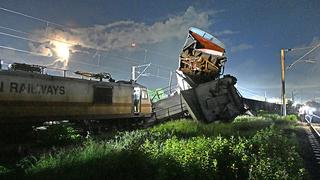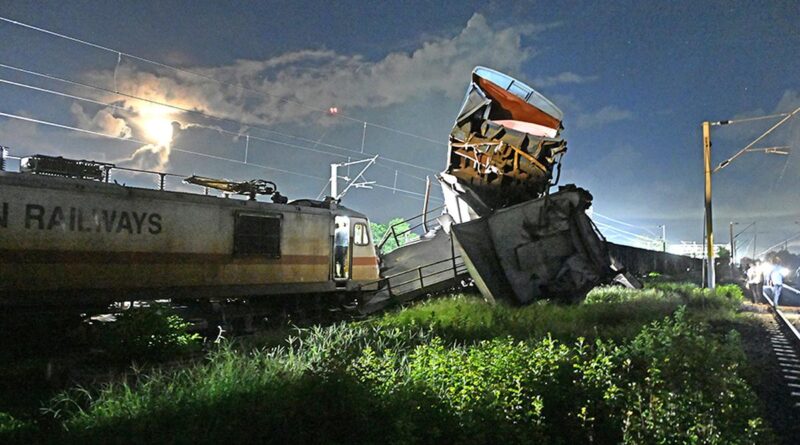What are the stress factors for Indian Railways?

The Mysuru-Darbanga Express rammed into a stationary goods train at Kavaraipettai Railway station near Gummidipoondi in the Chennai Division of Southern Railway late on October 11, 2024.
| Photo Credit: B. Jothi Ramalingam
The story so far: On October 17, eight coaches of the Agartala-Lokmanya Tilak Express derailed in Assam with no casualties. On October 11, a passenger train rear-ended a stationary goods train near Chennai, also with no casualties. Indian trains have been involved in multiple accidents of late. The Balasore accident on June 2, 2023, had the greatest death toll, more than 275, yet pressure on the Railways to improve safety competes with pressures straining its subsistence.
How common are accidents?
The number of railway accidents dropped from 1,390 per year in the 1960s to 80 per year in the last decade. There were still 34 consequential accidents in 2021-2022, 48 in 2022-23, and 40 in 2023-2024. A consequential accident injures and/or kills people, damages railway infrastructure, and disrupts rail traffic.
According to public records, 55.8% of all accidents involving trains have been due to the failure of Railway staff and another 28.4% due to failures on the part of non-staff people. Equipment failure accounted for 6.2%. In both the Balasore and the Kavaraipettai accidents, officials blamed the signalling system.
What is ‘Kavach’?
The ‘Kavach’ automatic train protection system is designed to prevent collisions using devices that allow pilots to track the relative location of their vehicles and which can actuate alarms and automated braking protocols.
Editorial |Take the gauntlet: On safety and the Indian Railways
By February 2024, the Railways had installed ‘Kavach’ on 1,465 route km, or 2% of its total route length. After the Balasore accident, Union Railway Minister Ashwini Vaishnaw said ‘Kavach’ would be implemented in “mission mode”. It costs ₹50 lakh per kilometre and ₹70 lakh per locomotive. An analysis by The Hindufound the all-inclusive cost of implementation over a decade to be less than 2% of the Railways’ annual capex. When faced with criticism of the slow implementation, officials have deferred to declines in accident incidence and mortality over the years. But experts have said comparing current and past accident rates is misguided because advanced safety technologies didn’t exist earlier and that the government has the means today to eliminate collisions.
Since 1990-1991, the Railways has classified nearly 70% of all major accidents as derailments, but only 2% of them were due to collisions. ‘Kavach’ also may not have prevented the Kavaraipettai accident because the relevant error happened beyond the minimum margins ‘Kavach’ requires to assist.
What is the operating ratio?
The operating ratio (OR) — the amount the Railways spends to earn ₹100 — in 2024-2025 is estimated to be ₹98.2, a small improvement from 2023-2024 (₹98.7) but a decline from ₹97.8 in 2016. A higher OR leaves less for capex and the Railways more dependent on budgetary support and Extra-Budgetary Resources (EBRs). In 2016-2017, the BJP government brought the railway budget under the regular budget after nine decades of separation. One outcome was easier access for the Railways to gross budgetary support. As for EBRs: the Railways’ dues have ballooned to 17% of its revenue receipts today from 10% in 2015-2016.

How are freight services faring?
The Railways’ two main internal revenue sources are passenger services and freight. The latter accounts for 65%. While revenue from both sources is increasing, freight rates increased more than thrice as fast as passenger rates in 2009-2019, NITI Aayog has estimated.
According to the draft National Rail Plan, nearly 30% of the railway network is utilised to more than 100% capacity. This has translated to slow freight movement — around 26 km/hr in 2016 — and slower revenue growth. Of the Dedicated Freight Corridors (DFCs) the government mooted in 2005, only the eastern DFC is fully operational. The western DFC is partly ready; the east coast, east-west sub-corridor, and north-south sub-corridor DFCs, amounting to 3,958 km, are still in planning. Freight revenue also depends on the freight basket. Coal accounted for half of the freight revenue and 45% of volume in the 2024-2025 budget estimate. However, the government has been adding more renewable energy sources while pushing industries to reduce their dependence on fossil fuels, including coal.
The Railways also needs to keep up existing equipment, including replacing tracks and wagons and maintaining trackside infrastructure. But in the 2023-2024 budget, capital outlay for track renewal dropped to 7.2%. Appropriations to the Depreciation Reserve Fund also fell 96% in the BJP’s first term; the government had moved these resources to the Rashtriya Rail Sanraksha Kosh safety fund created in 2017-2018. The Standing Committee on Railways said then the latter wouldn’t be able to pay to repair or replace depreciating assets.
What about passenger services’ revenue?
The Railways’ freight profit is offset significantly by passenger losses. In 2019-2020, the revenue from passenger services was a little over ₹50,000 crore and loss, ₹63,364 crore. In 2021-2022 — a pandemic year in which many trains had to be cancelled — passenger services incurred a loss of ₹68,269 crore. In a July 2024 analysis, PRL Legislative Research estimated the revenue from passenger services was ₹80,000 crore in 2024-2025.
PRL also estimated the Railways had a passenger traffic of 11 lakh passenger km, expected to increase to 12.4 lakh in 2024-2025 thanks to the addition of new trains — including the Vande Bharats — on high-traffic routes. The Railways has also replaced many of the more affordably ticketed sleeper and second-class coaches with the more expensive AC coaches, all to increase passenger revenue. However, it last rationalised passenger fares in 2020.
How is safety affected?
For a long time now, the Railways has been caught between two aspirations: providing an affordable travelling option to the Indian people versus being a profitable business.
The Railways’ losses are compounded by growing wage and pension bills and fuel costs. Locomotive pilots have also reported stressful working conditions, including 12-hour shifts, especially in zones with large freight volumes, and shifting standard operating procedures.

The high network congestion is likewise exemplified by the limited utility of ‘Kavach’ as well as the failure of a homegrown system, based on walkie-talkies, to alert trackside workers to oncoming trains. “The system does not work fully … where a number of trains ply in a single block section at close intervals and signals are placed 1 km apart,” Mr. Vaishnaw told the Rajya Sabha in 2023. In sum, the Railways’ inability to generate revenue to plug gaps in the gross budgetary support, burgeoning demands on its revenue receipts, and growing pressure to ease congestion and improve physical capacity mean it’s constantly playing catch-up.
Published – October 20, 2024 03:05 am IST

